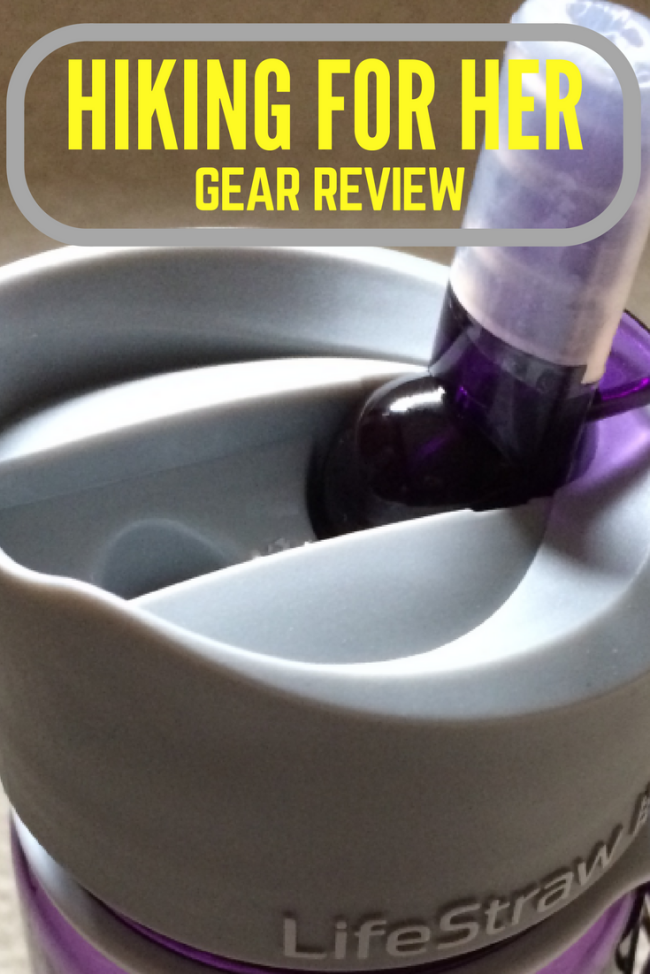
Lifestraw Go Water Bottle Review:
Affordable Water Filtration For Hikers
By Diane Spicer
This Lifestraw Go water bottle review has two goals:
- To present the logic behind this approach to water filtration for hikers
- To share my observations about using this 2-stage filtration water bottle
The underlying question in this review:
Is this a necessary piece of hiking gear?
But first, some disclosures
in this Lifestraw Go personal water bottle review
Hiking For Her received this product from Lifestraw (by Vestergaard) in exchange for an honest gear review.
As always on this website, this hiking gear review will point out the good features right along with the bad, from the perspective of a seasoned hiker.
The technical specifications shared in this review are from the Lifestraw company.
- I did nothing to verify this data.
Hiking For Her is the source of the opinions, observations and photos in this Lifestraw Go water bottle review.
- If you read this detailed review and decide to purchase these filtration water bottles through the links on this website like this REI Co-op one or this Amazon link, HFH will receive a small percentage of your purchase price.
- You will be charged nothing extra.
- Hiking For Her only recommends what works, because that's the honest thing to do.
One more disclosure:
I'm a retired microbiologist
Micro-organisms are just about the most fascinating thing on the planet to me.
I spent many years studying and working with them: clinical hospital labs for pathogen identification, research labs and teaching labs working with students to increase understanding of how microbes help and harm us.
This means I feel able to share a unique perspective on this water filtration method.
But I'm also a hiker with 50+ years of trail experience, so I know great hiking gear when I handle it.
Let's see what this combination of microbiology and hiking experience comes up with!
Lifestraw Go water bottle review:
first impressions
I always take a hard look at the packaging and marketing of a new piece of hiking gear.
If a company cares about the way the product is presented, and the messaging on the package is realistic, it sets my expectations of good things to come.
Here's the Lifestraw Go cardboard package.
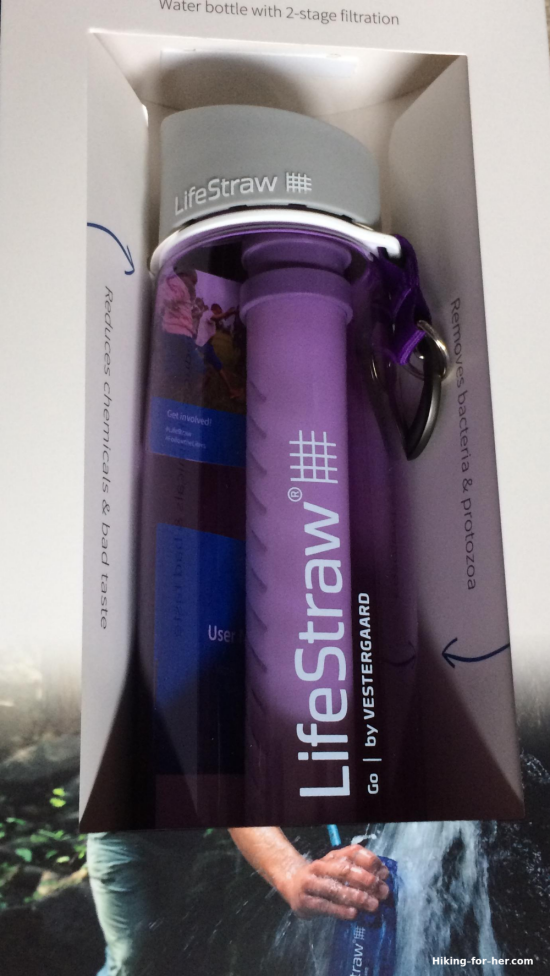
No plastic to wrestle with, which is appreciated.
There are two plainly stated benefits when using this bottle, valuable to any hiker who needs to replenish her supply from surface water along the trail:
- Removes bacteria and protozoa
- Reduces chemicals and bad taste
Questions to ask in this review
Here is our first opportunity to ask a few microbiology questions:
- What percentage of bacteria and protozoa can I expect this filtration water bottle to remove?
- What about virus removal? In particular, I'm worried about certain types of hepatitis and rotavirus which are environmentally hardy and very hard to remove from water on a hike.
My curiosity is also piqued by the statement about chemicals:
1. Where am I likely to run into dangerous chemicals in a surface water supply while hiking? (Cynical answer: Everywhere streams and lakes are found.)
2. Will this two stage filtration improve the taste of the chlorinated public water supply I use at home?
- In other words, can I use this water bottle at my computer desk as well as on the trail?
It's good to have technology to remove odors, because if the water stinks you will be less likely to stay hydrated.
We'll return to these questions later in the review.
More observations about Lifestraw Go
Another initial observation which bodes well for a good user experience on the trail:
This filtration method doesn't rely on a pump, something which I am keenly interested in experiencing.
- If you've ever pumped water in the back
country, you know what I mean: clogged pump, back flow issues, the
weight and bulk, your tired hands.
I also noted that the filters are replaceable, meaning a one time investment in the Lifestraw Go water bottle will keep it out of the landfill once the filters need to be swapped out.
- Are the filters recyclable? I couldn't find this information.
And now, the obvious question: How long do the filters last, in terms of gallons/liters of water filtered?
- And do they have to be handled in any particular way between uses?
Keep all of these questions in mind as this Lifestraw go water bottle review rolls along.
Lifestraw Go water bottle review:
technical specifications
If you're just starting out as a hiker, it's important to realize the value of the technical "specs" provided with a piece of gear.
And with something as important as filtering your drinking water, it's doubly important to understand what this product can, and cannot, do for you on the trail.
It's also important to take a few minutes to go through the user manual, provided inside of the bottle in English and French.
Why?
There's a bit of learning curve (summarized below) with this Lifestraw Go water bottle, and you don't want to build up frustration by skipping the hints for its usage.
Now for the specifications, with a few comments.
- Weight: 5.9 ounces/168 grams including the filters. This is featherweight compared to some hiking water bottles I already own.
- Size: 9.25 inches/235 mm long and 3.14 inches/80 mm in diameter, slightly more slender but the same height as other water bottles typically used by hikers. This bottle fit easily into my mesh side pockets of my backpacks (both day packs and backpacking packs).
- BPA free
- Volume: 22 ounces/650 ml. This is an important number, because you need to keep track of how many liters of water you've run through the replaceable filters. See detailed comments under "personal responsibility" below.
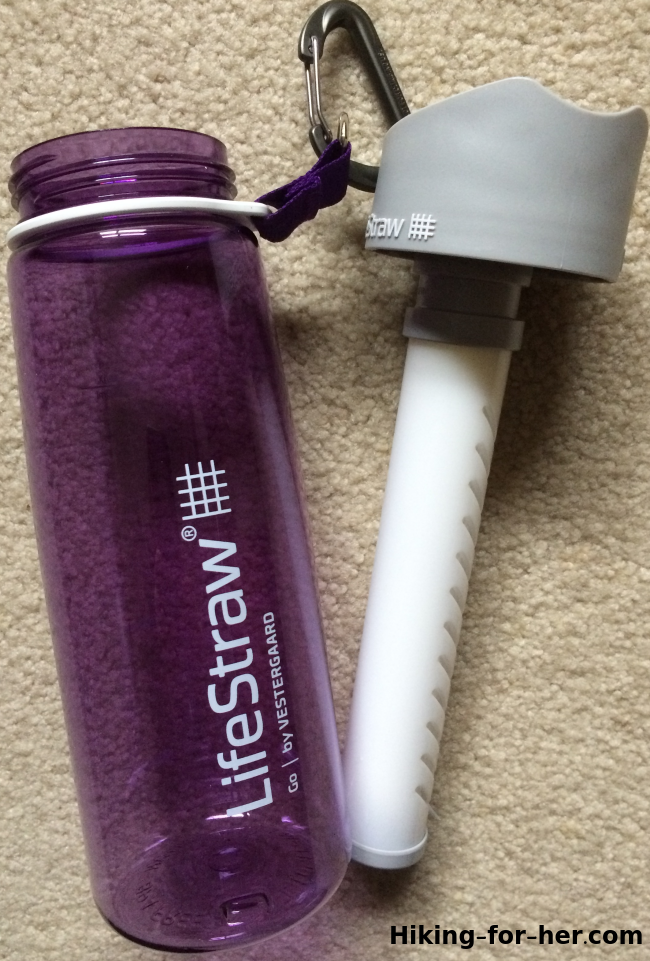
There are two filtration devices: Stage 1 inside the white plastic chamber, and Stage 2 in the small gray section between Stage 1 and the lid.
Each can be replaced independently.
Stage details
The Stage 1 hollow fiber membranes (inside the lower portion in the photo above) are rated at 99.9999% removal of coliform bacteria (E. coli and others).
- The scientist part of my brain wonders what's up with the
four decimal places, since bacteria are measured in the lab as whole
units by counting colonies.
- The hiker in me says, Hurrah! Literally all of the little critters are gone when the filter is performing correctly.
- It also removes 99.9% of protozoa. Read why you really like the idea of waterborne pathogens such as Giardia and Cryptosporidium being removed.
The Stage 2 activated charcoal capsule (upper section, near the screw in area on the lid) does not eliminate anything. Instead, it reduces chlorine, bad odors, bad tastes, and organic chemicals such as pesticides.
- Sounds like a worthy goal to me.
- Activated charcoal has been used in this way for a long, long time.
- So I know it will work to sop up the nasty chemicals I might encounter in water sources - but not eliminate them entirely.
If EPA (Environmental Protection Agency) standards are important to you, rest assured that the filtered water meets US EPA drinking water standards.
Slight learning curve in
Lifestraw Go water bottle review
As previously mentioned, it's important to at least skim the User Manual for clues on getting the best performance out of a new piece of hiking gear.
And the microbiologist in me definitely wants those 2 filters to work at peak performance, keeping potential waterborne bacteria out of my digestive tract.
So here's the short, sweet version of your water bottle learning curve:
- Remove the carbon capsule and let clean tap water flow over it.
- Prime the filter unit with water for a few seconds before sipping. This is important for proper functionality not only the first time, but any time the filter unit has dried out.
- You will have to pull hard for the first few sips to get the water flowing through the filter. A few quick sips should do the trick.
- The flip top bite valve habit might be new to you.
- To store this water filtration device after your hike, unscrew the filter unit (easy to do), rinse it in safe potable water, and don't put it away wet.
- I didn't time how long it took to dry out, letting it sit for a few days at room temperature.
- Outdoor conditions will vary (temperature, humidity) so I have no comment on what you will experience outdoors.
Lifestraw Go water bottle review:
user experience
Let's get this out of the way first: I didn't use this water bottle through its complete filter replacement cycle yet, so I don't know whether or not this is a true statement from the manufacturer:
"Lifestraw Go will no longer filter water when the product
has reached the end of its working life."
Your first clue?
You won't be able to get any water to flow into your mouth.
- I will report back on the accuracy of this statement, once I need to replace the filters - lots of hiking miles from now.
More observations on handling this water bottle on a hike
My hands are small, and I sometimes have trouble with wide diameter bottles.
- Because this bottle is slightly tapered toward the top, and more slender than other hiking water bottles I've used, I was able to grasp it easily.
I practiced removing the filtration pieces a few times, and am sure it would be easy enough to do this "for real" when the time comes.
- The carbon capsule has a groove on it, so you can pry it out using a (clean) fingernail.
Pre-filtration tips
If your water supply is visibly "dirty" with debris, leaves, sand and grit, pre-filter it before putting it into your Lifestraw bottle.
My crude but effective method, which needs a few supplies stashed in a backpack:
- Put a clean bandanna over the mouth of the bottle.
- Be sure to hold it in place, or have a trail buddy do this.
- Using your metal cup (an addition to my Ten Essentials list), pour the dirty water into your newly created cloth funnel.
- This traps the large debris and gooey gunk, allowing the two stage filtration inside the bottle to work efficiently.
Another approach to pre-filtration if you have time:
- Carry a dedicated "dirty" water bottle or ziplock bag (clearly marked).
- Fill it with the less than clear water and allow gravity to pull the big stuff to the bottom.
- If there's direct sunlight, why not allow the sun's UV rays to help you out, too?
- Once the bottom of the bottle is covered with silt, leaves, sand and other debris, fill up your filtration bottle carefully from this water source.
- Protozoal cysts (which open up inside your intestinal tract) will also settle out, if given enough time.
It goes without saying that you've cleaned your hands before doing any of this work.
Do your microbiologic part
when you use the Lifestraw Go
It does you no good to use this hiking technology if you re-contaminate the filtered water before you ingest it.
And it's important to me in writing this Lifestraw Go water bottle review to share tips on how to keep yourself out of trouble when using this filtration technology.
To ensure clean water, do these things
on the trail
Handle the filters or mouthpiece with clean hands.
- My recommendation: Have a small plastic bag with hand sanitizer or instant dissolving soap flakes to clean your hands before handling your bottle during a refill procedure.
- The drinking straw flips out, and folds out of the way. Don't kid yourself about your ability to keep this part clean on a hiking trail.
- I'm going to be using a non toxic pre-moistened towelette to keep the mouth part clean (again, it's all of that microbiology training.) (You might not want to go to those lengths. Unless you hike with microbiologists.)
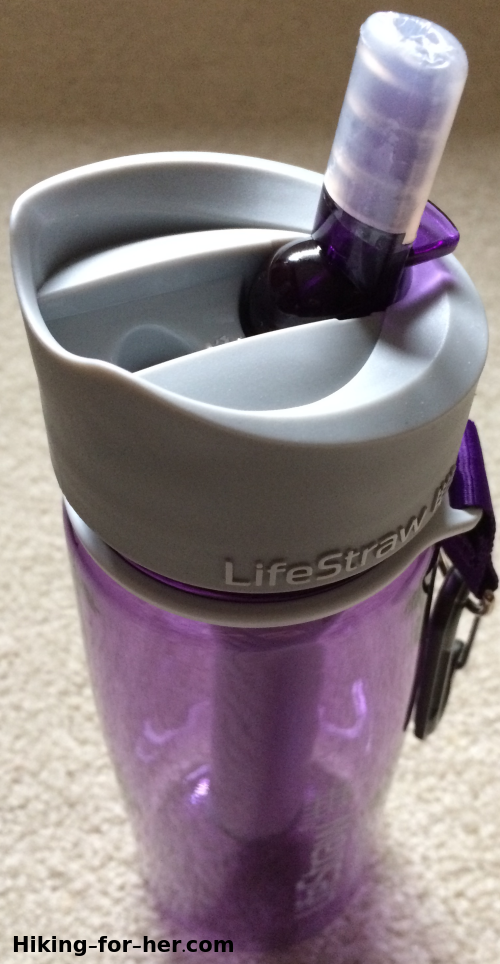
This photo shows the pop up lid still encased in its thin protective plastic layer.
You'll know to remove it because there's no opening in the straw until you do.
Or perhaps because you read this entire Lifestraw Go water bottle review ;)
Keep your Lifestraw Go to yourself
Sometimes NOT sharing is caring.
Think of it this way.
Not sharing water gives you a better chance of having at least one member of the hiking group in good shape if anything goes wrong with one of the filters.
Also, each hiker has a different tolerance for the microbes which occur in surface water. What upsets your microbial balance might not faze another hiker.
- To each, her own Lifestraw Go.
- Five nice colors to choose from, to avoid mix-ups!
No miracles!
Don't expect this filter system to work miracles
Where there's poop, coliform bacterial danger lurks in associated contaminated water.
- If you're hiking in areas with a lot of animal manure, whether it's cow, horse, sheep, goat, pig, elk or deer, expect the water to be less than pristine.
- Also to keep in mind: Humans are notoriously lax about their bathroom hygiene habits. I've seen human stool right next to alpine lakes, or on the banks of a mountain stream.
My recommendation on a backpacking trip: If you have a back up system of water purification, use it in high traffic areas. Read my backpacking water purification tips for more information.
On a day hike to areas with heavy human traffic, bring clean water in another water bottle and rely on the Lifestraw only when you need a refill. If you're taking good care of your filters, you should have no worries about this technology.
Viruses pass through
This water filtration method does nothing to protect you against viruses
- That would require more powerful filters to trap these incredibly tiny "potentially alive" (inert until they get into a living cell) particles.
- My recommendation: If you have any concern or suspicion about the water you're drinking in terms of fecal contamination, boil your water for at least 5 minutes. It's the safest way to know you've destroyed all viral particles.
- UV rays in sunlight are also germicidal, effective against bacteria (but not bacterial spores) and viruses. If you have an abundance of time to let your filtered water sit in direct sunlight for several hours, you can knock down the viral load (if there is any) somewhat.
- Or consider this 3 stage water filtration bottle from Water-to-Go.
Lifestraw Go water bottle review conclusions
So to answer the question I posed at the beginning, is this a necessary piece of hiking gear?
I say yes for backpacking trips or long, thirsty day hikes.
- You're going to need to refill your water supply.
- You want the peace of mind that comes with having a safe hydration plan.
- You can drink directly from streams and other surface water.
- You can use this filtration bottle as a back up plan, too.
After handling and using this Lifestraw Go water bottle, I can say two things with absolute certainty:
- I will be bringing this piece of hiking technology along on every future backpacking trip to supplement my preferred water purification method (boiling).
- I can heartily recommend this filtration approach to you when you want to go as fast and light as possible but still have a reliable water purification method.
Tastier water?
Remember me asking if this water bottle could improve the taste of my municipal drinking water?
- Why yes, it could and did.
- Using it every day at my desk will cut into the life of the filter, with filter replacement coming up much more frequently.
- But if your drinking water at home tastes weird, try out this Lifestraw 2 step filtration approach.
Here's more to love about a Lifestraw Go
And there's this delightful commitment to socially responsible hiking:
At the time of this writing, when you purchase a Lifestraw product, one child somewhere in the world receives safe drinking water for one school year.
What's not to like about that??
To be thorough in this Lifestraw Go
water bottle review:
A few cautions
This is a thin plastic water bottle, with a delicate (in my opinion) plastic case holding the Stage 1 filter.
I can easily visualize myself dropping this pretty purple bottle, or just the case, on an abrasive granite boulder, and watching my water purification system go bye-bye.
- So I will make a point to stand on a stable surface, with my full attention on the bottle, when I'm handling it.
- When the lid is off and the filter is exposed, I won't set it down or allow it to contact my water source directly (why soak up an entire pond's worth of bacteria?).
- If I drop it hard enough to see cracks, I won't rely on it any more (common sense, right?).
- And in an abundance of microbiological paranoia, I will carry a replacement Stage 1 filter with me on long hiking trips that rely exclusively on this filtration method for surface water.

A few more cautions
in this Lifestraw Go water bottle review
This bottle won't be coming along on my snowshoeing adventures, where cold overnight temperatures can mess up the filters.
- Ditto for my hikes for weeks in extremely hot conditions with little protection from UV rays.
The caribiner/loop/rigid plastic attachment system on the outside of the bottle looks good in theory, but when the bottle was full of water I caught myself wondering if I should skip it and pick up the bottle directly.
- Probably not a problem, but I'll report back if this system fails.
- Could be handy to clip in the bottle to a backpack or on a raft, for handy access.
I predict that the biggest challenge with using this water bottle will be keeping my hands clean enough to keep the filtered water uncontaminated!
A plug
for personal responsibility
Taking good care of yourself on a hike is your responsibility.
If you're a seasoned hiker, you carry the ten essentials.
You diligently practice Leave No Trace principles.
But you will have no idea how many liters you've filtered with this handy, lightweight, well engineered device if you don't keep a log.
This leaves you vulnerable to "it's probably ok" false confidence in your water supply.
- Use your trail journal to record the number of refills for this water bottle.
- There are two metrics to track, with replacing the filters in a timely manner as the end goal.
- Note that the volume of this bottle is less than one liter, 650 ml to be exact.
- If you want to be extra cautious, you can record one fill up as a liter, and know that your filters will be replaced slightly before they max out.
- If you're a math geek, you can track the actual volume each time.
Your water filter replacement targets
Here are some numbers you'll need to record in your trail journal:
- Replace the hollow fiber membrane after 1,000 liters.
- The
activated carbon capsule will perform well for 100 liters of filtration.
- If you're hiking in areas with known chemical contamination of surface water (agricultural or mining run off, sprayed pesticides, etc.) you need to be scrupulous about the activated carbon number.
- If you hike in areas with potential for poop contamination (realistically, everywhere in the lower 48 States with a few rare, wonderful exceptions), you're more concerned with replacing the hollow fiber membrane which traps pathogens.
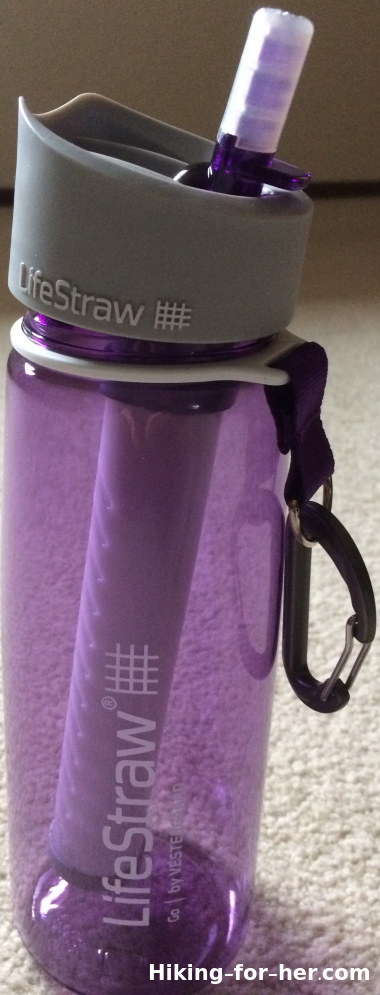
If you would prefer to carry just the personal water filter, check out my Lifestraw review.
Questions about this Lifestraw Go
water bottle review?
The whole point of this website is to provide a forum for you to ask questions and to get answers.
Use the Ask A Question link to send me anything you're still wondering about, and I'll be happy to answer.
- I read, and answer, all of my own email.
- If I'm "out in the field" (gear testing or in the back country) it might take a few days to a few weeks to get back to you, but I will!
- If you don't get an immediate auto reply to your question, your email never reached me. Try again, using a different email address, until you get the "Thanks for your email" message.
Have faith in me, and this Lifestraw Go water bottle review.
Within reason, of course :)
Ready to add a Lifestraw Go to your trusted hiking gear?
- Go here (slight pun, hope you don't mind)
Home page > Hiking Gear Reviews >
Lifestraw Go Water Bottle ReviewPian
Pin this Lifestraw Go water bottle review for later!
|
I get emails all the time about what I wear, eat, carry and love to use on the trail. That's
why I provide affiliate links to you: the best gear that I use myself and have seen used by other hikers is instantly
available for your consideration, and the gear company sends a few
pennies per dollar to this reader-supported hiking website. There is no added cost to you! Everyone ends up a winner: Great gear for you, strong gear companies, and more free hiking tips for everyone. Thanks very much for your support. It's warmly and sincerely appreciated. It also helps send these hiking tips to all your virtual trail buddies around the globe. |
 |
